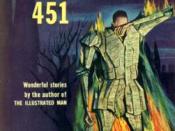The Dreary and Menacing Future of Technological Advancements
Ray Bradbury's novel, Fahrenheit 451, published in 1953, depicts a grim and also quite feasible prediction of a futuristic world. In Bradbury's technology-obsessed society, a clear view of the horrific effects that a fixation for mindlessness would have on a civilization shows through his writing. Being carefree is encouraged while people who think "outside the box" are swiftly and effectively removed. The technology Bradbury's society is designed to keep the people uninformed, which the vast majority of are happily and voluntarily in their ignorant state. There are many details in this novel that suggest that the future of a society obsessed with advanced technology is not only bleak but also dangerous.
Bradbury's use of certain machines shows the emphasis his society has on thoughtlessness. For example, a commonly referenced appliance is the parlor wall. The parlor walls keep people thoughtless by blasting noise and colors at its audience, which is evident in the passage: "A great thunderstorm of sound gushed from the walls.
Music bombarded him at such an immense volume that his bones were almost shaken from their tendons; he felt his jaw vibrate, his eyes wobble in his head. He was a victim of concussion"(45). The speed of which the shows hit their viewers is so intense that one cannot think or grasp on to any sort of thought. Another key example of technology promoting a thoughtless society is the earpieces. Earpieces are small enough to place inside your ear, where, when in place, broadcast the noise from the parlor walls. Mildred, throughout the entire novel, wears her earpieces, "She had both ears plugged with electronic bees that were humming the hour away"(18). The technology in school also illustrates how thinking for oneself and being an individual is considered...


